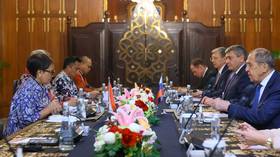RUSSIA HEADS TO SOUTHEAST ASIA – THE NEXT SUPERPOWER AFTER CHINA TO WARN ASEAN NATIONS TO DUMP THE TOXIC U.S. DOLLAR & EURO IN BUSINESS SETTLEMENTS – APART FROM SWITCHING TO THEIR OWN NATIONAL CURRENCIES, ASEAN NATIONS CAN ALSO OPT TO USE THE RUSSIAN RUBLE, CHINESE YUAN & UAE DIRHAM
Russia seeks to expand de-dollarization drive
Russia is planning to discuss a switch to national currencies in trade with countries in Southeast Asia, the Foreign Ministry announced on Tuesday. The move comes as part of Moscow’s push to ditch the US dollar and euro in business settlements.
As a result of Western sanctions against Moscow, trade turnover between Russia and countries in the Association of Southeast Asian Nations (ASEAN) decreased by 4.4% in 2022, the ministry said in a statement ahead of Foreign Minister Sergey Lavrov’s visit to Jakarta, Indonesia.
“To improve the situation, Russia is working on launching consultations on introducing national currencies in mutual settlements,” the Foreign Ministry said on its website.
ASEAN is a political and economic union of Brunei, Cambodia, Indonesia, Laos, Malaysia, Myanmar, the Philippines, Singapore, Thailand, and Vietnam. Lavrov is in Jakarta this week to meet with his ASEAN counterparts to foster stronger ties.

Following the imposition of sanctions, Russia and its trading partners among developing nations have intensified efforts to reduce the use of the Western financial system and replace the US dollar and the euro with national currencies for trade settlements.
The trend is supported by the members of BRICS, the economic bloc uniting Brazil, Russia, India, China, and South Africa, as well as numerous other nations that want to join the union. Among the currencies widely used instead of the US dollar are the Russian ruble, Chinese yuan, and UAE dirham. RT.COM
East Asian states need to strengthen guard against ‘great external threat’

Photo: VCG
ASEAN-plus Foreign Ministers’ Meetings will be held in Jakarta, Indonesia, on Thursday and Friday. Wang Yi, Director of the Office of the Central Commission for Foreign Affairs, will attend the gatherings, demonstrating China’s high regard for the meetings and China’s relationship with ASEAN. The meetings will focus on several topics related to regional peace, stability, and economic recovery. We would like to take this opportunity to sincerely remind ASEAN to strengthen its vigilance against external forces instigating trouble, as this has become the most serious external threat that could undermine the cooperation environment and development momentum between ASEAN and regional countries.
In recent days, foreign media have been hyping the South China Sea issue. Even before this year’s relevant meetings started, the US has been continuously making statements, trying to set the tone for the meetings in advance. Prior to US Secretary of State Antony Blinken’s visit to Jakarta, the US State Department claimed that his trip aimed to closely cooperate with Southeast Asian countries to “counter” China’s actions in the South China Sea. The Japanese media also mentioned that the participation of Japanese Foreign Minister Yoshimasa Hayashi aimed to rally ASEAN countries to restrain China and further intensify the South China Sea issue. Furthermore, the US, Canada, Australia, and some European countries recently started to make an issue of the so-called South China Sea arbitration ruling.
Regarding these high-profile political shows, we believe that ASEAN will remain clear-headed and calm. As a matter of fact, ASEAN is already vigilant about this. Indonesian Foreign Minister Retno Marsudi, stated in her opening speech at the ASEAN Foreign Ministers’ Meeting, “We need to send a clear message that ASEAN will never be a proxy in great powers’ rivalry.” Over the past two years, ASEAN representatives have repeatedly reiterated this position in various major multilateral occasions, indicating that they have felt pressure from this aspect and are aware of the huge risks involved.
Currently, there are two forces engaging in a game in the South China Sea region. On one hand, the US is intensifying its containment and suppression on China, continuously creating conflicts in the region in an attempt to drive a wedge between China and ASEAN. On the other hand, the regional countries strongly desire stability, peace, and development. Particularly after taking some detours in handling the South China Sea issue in previous years, countries have realized how important it is to properly address sensitive hotspot issues. In recent years, major regional countries have explicitly or implicitly rejected picking sides, signifying a collective sobriety and rationality within the region.
However, in the foreseeable future, the intensity of external forces’ involvement in East Asian affairs will only increase rather than weaken, and their methods will be more covert and deceptive. Under the guise of promoting “cooperation” and “security,” their actions involve decoupling, provoking friction, and fostering confrontation, in order to entice regional countries into joining the camp that seeks to contain and restrain China. All 10 ASEAN countries are China’s neighbors, and the US not only aims to rope ASEAN as an organization in, but also adopts a strategy of divide and conquer among its member states. US officials have paid increasingly frequent visits to ASEAN countries, and the South China Sea issue has become the biggest leverage point for the US and its allies to exploit.
It’s a reality that there are disputes concerning the South China Sea issue. However, China and countries directly involved have together put this dispute under control, preventing it from becoming an insurmountable obstacle to economic and diplomatic cooperation and friendship among all parties. It is a common goal for everyone to turn the South China Sea into a sea of peace, friendship and cooperation, and significant progress has already been made. ASEAN has played an irreplaceable constructive role and has met China halfway in promoting the “Code of Conduct in the South China Sea.” The tense situation in the South China Sea is not in the interests of ASEAN countries and China.
Every time relevant negotiations in the South China Sea show signs of progress and the situation appears to be easing, the US takes action. It either sends warships and military aircraft to the South China Sea to flex muscles, or defames China’s legitimate actions in the waters. It also incites relevant countries in the South China Sea to confront China. The calmness in the South China Sea is obviously not what the US and other countries hope to see. They first stir up external public opinion regarding the South China Sea, and then disrupt the situation in the region. It cannot be ruled out that certain countries in the South China Sea may make wrong choices and set a wrong example. In this regard, regional countries need to keep their eyes open.
Against the backdrop of challenges such as global economic slowdown and geopolitical conflicts, the overall situation in East Asia is a bright spot, and the high-level mutually beneficial and win-win relationship between China and ASEAN is the highlight of this bright spot. This is not easy to achieve and has become a model of the most dynamic and fruitful achievements in the Asia-Pacific region, effectively promoting regional peace, stability, and prosperity. This situation needs to be cherished and jointly maintained by all parties, especially in the face of “external threats.” GT
Balakrishnan, Wang Yi discuss S’pore and China speeding up recovery in air travel, business links

Singapore’s Foreign Minister Vivian Balakrishnan and China’s top diplomat Wang Yi affirmed the strong relationship between the two nations. – MINISTRY OF FOREIGN AFFAIRS
JAKARTA (The Straits Times/Asia News Network): Singapore and China will continue to accelerate post-pandemic recovery, focusing on areas such as air travel and business.
Singapore’s Foreign Minister Vivian Balakrishnan met China’s top diplomat Wang Yi on Wednesday, where they affirmed the strong relationship between the two nations, following the recent upgrade to an “All-Round High-Quality Future-Oriented Partnership”, said the Ministry of Foreign Affairs (MFA).
The leaders were meeting on the sidelines of the 56th Asean Foreign Ministers’ Meeting in Jakarta.
“Minister Balakrishnan and Director Wang discussed how Singapore and China can accelerate post-pandemic recovery. The full resumption of air connectivity and enhancement of business and people flows were key priorities,” said the MFA.
“They looked forward to a substantive 19th Joint Council for Bilateral Cooperation meeting, co-chaired by Deputy Prime Minister and Minister for Finance Lawrence Wong and Vice-Premier of the State Council Ding Xuexiang, later this year.”
In his opening remarks, Dr Balakrishnan said the meeting was between “old friends” and that Singapore has long supported the development of Asean-China relations.
“Today is also a good opportunity. We are old friends and see each other often, I would be keen to hear your views on current developments, and also your aspirations on strengthening bilateral ties,” he told Wang.
The MFA said that Dr Balakrishnan and Mr Wang had a wide-ranging exchange of views on regional and international developments, and reiterated their commitment to strengthening the Asean-China Comprehensive Strategic Partnership.
“They reviewed the good progress in bilateral cooperation, including in the three government-to-government projects in Suzhou, Tianjin, and Chongqing, as well as the China-Singapore Guangzhou Knowledge City,” said the MFA. “The Tianjin Eco-City will commemorate its 15th anniversary this year, while the Suzhou Industrial Park will mark its 30th anniversary next year.”
From Thursday, Asean foreign ministers will meet Wang at the Asean-China Post-Ministerial Conference and at the Asean Plus Three Foreign Ministers’ Meeting, which includes their counterparts from Japan and South Korea.
US Secretary of State Antony Blinken and Russian Foreign Minister Sergei Lavrov are among the foreign leaders expected to be in Jakarta.
In a Facebook post on Wednesday, Dr Balakrishnan said that projects between Singapore and China are doing well. “We will continue to explore cooperation in new areas, including the green and digital economies.”
Dr Balakrishnan also met the Saudi Minister of Foreign Affairs, Prince Faisal Bin Farhan Al Saud. He noted that Asean had on Wednesday welcomed Saudi Arabia’s accession to the Treaty of Amity and Cooperation in South-east Asia (TAC).
The TAC is an Asean peace treaty, and is a prerequisite for more formal partnerships with the regional bloc.
“Prince Faisal and I had a good exchange on developments in our respective regions, and discussed ways to strengthen cooperation between Singapore and Saudi Arabia,” said Dr Balakrishnan.
In a meeting with New Zealand’s Foreign Minister Nanaia Mahuta, Dr Balakrishnan said she shared that South-east Asia is an area of huge opportunities for her country.
“We had a good discussion on deepening bilateral cooperation, including in traditional sectors and emerging areas such as climate change and the green economy,” he added.covery in air travel, business links. ST
RT.COM / GLOBAL TIMES / STRAITS TIMES
.
